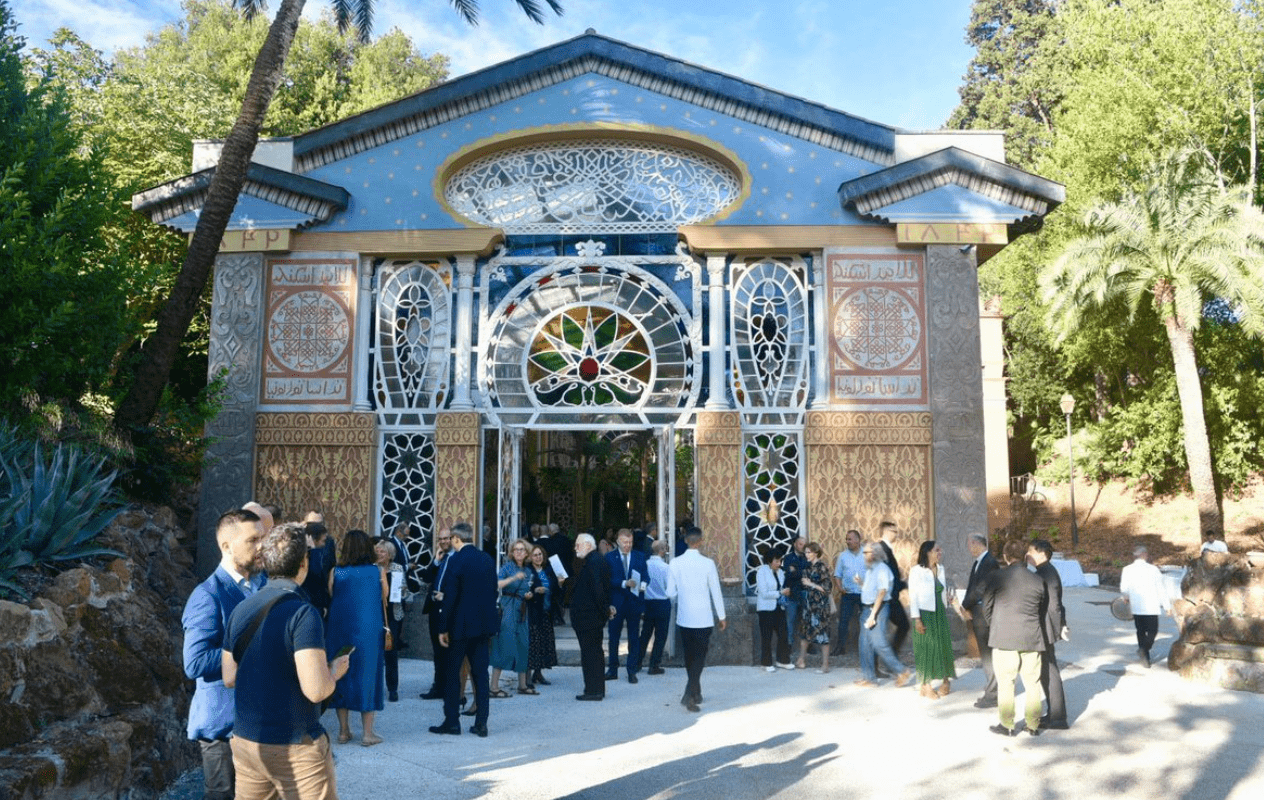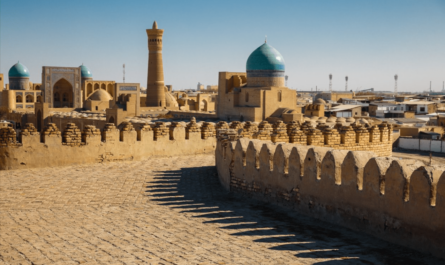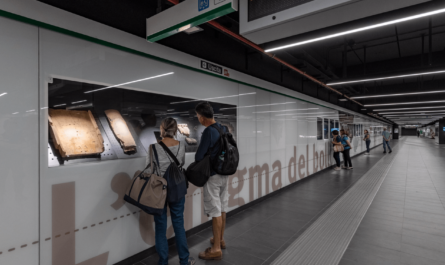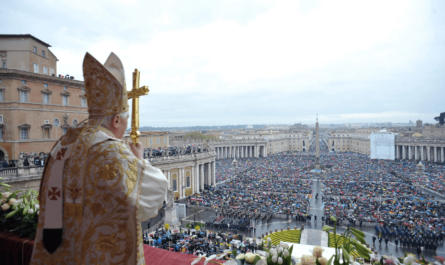Serra Moresca, known as the Moorish greenhouse in Italian, languished in poor condition for decades before being reopened to the public recently following extensive renovations by the Roman Council.
Like the other structures in this unique Roman park, it features distinctive architecture, striking decorative patterns, and optical illusions.
With its vibrant polychrome glass doors and windows, and elegant design in peperino rock, iron, and cast iron, Serra Moresca now radiates the same charm and sophistication that once greeted the guests of Prince Torlonia during its prime.
The artificial grotto, small lakes, interplay of light, and an assortment of exotic plants enhance the eclectic style of Villa Torlonia, making it a must-visit spot in Rome, particularly for those staying more than three days.
History of Villa Torlonia’s Serra Moresca
Constructed between 1839 and 1840 by architect Giuseppe Jappelli, who also designed the Casina delle Civette within the same Villa Torlonia park, Serra Moresca is a greenhouse crafted in Moorish style. Jappelli was commissioned by Prince Alessandro Torlonia, who admired Jappelli’s previous English-style gardens. Inspired by the Alhambra in Granada, Jappelli brought a piece of Andalusia to Rome.
Prior to his Rome commission, Jappelli had worked on Villa Saonara and Villa Treves in Padua, incorporating elements of English-style gardening, such as a grotto, a temple, and Gothic ruins.
Serra Moresca stands out in the Roman artistic and architectural landscape, with few other projects from earlier periods sharing its unique characteristics. Notable examples include the Aesculapius temple at Villa Borghese, created by Antonio Asprucci in the late 18th century. Despite these landmarks, English-style gardening never became a prominent cultural feature in Rome.
The first modifications to Serra Moresca occurred in 1905, including the addition of a gardener’s house, which became a poultryman’s residence in 1920.
Like other structures at Villa Torlonia, Serra Moresca was found in a state of severe disrepair. Restoration efforts were aided by historical documents, such as an 1842 description by Italian politician Giuseppe Checchetelli, a 1905 evaluation by architect Parisi, and original drawings by Giuseppe Jappelli.
Architecture of Villa Torlonia’s Moorish Greenhouse
Inspired by the Moorish architecture of the Spanish Alhambra, Serra Moresca was designed to evoke the locations described by Ludovico Ariosto in his Orlando Furioso.
Often referred to as a “stufa” or heater due to the warmth required for exotic plants, the Serra Moresca greenhouse is a spacious area with a high glass ceiling, colorful side windows adorned with intricate Moorish designs, and a wall-mounted fountain.
The greenhouse’s longer walls are flanked by stone pillars carved with Moorish patterns and covered with trompe l’oeil curtains. The front wall facing the entrance is similarly decorated with bright colored glass windows, enhanced with mirrors to amplify the reflective effects.
Painter Giacomo Caneva, drawing inspiration from James Canavah Murphy’s The Arabian Antiquities of Spain, created the decorative elements of the greenhouse.
Entering Serra Moresca feels like stepping into a hidden garden rather than a mere greenhouse. The interplay of light and color, along with exotic plants such as palms, pineapples, aloe, and agave, creates a unique atmosphere. Though the space is compact, it provides a relaxing environment with seating for visitors.
Modern times have not been kind to this colorful retreat, with several features lost over the years. Originally, Jappelli envisioned a sliding panel for a small orchestra, which was removed by 1905. A fountain, supported by a cast-iron female figure now in Casino dei Principi, replaced it.
The area now serving as the bookshop and ticket office was once the passage connecting the greenhouse to the kitchen on the upper floor. Above the door, an inscription in Kufic characters translates to “God’s blessing descend on Prince Alessandro Torlonia, powerful in God,” echoing the tribute to the Torlonia family seen in other buildings.
Tower and Grotto
After visiting the greenhouse, consider a leisurely tour of the tower, the remnants of the artificial grotto originally known as Nymph (Nymphae Loci), the faux ruins, and the small lakes and waterfalls adorned with lotus flowers and water lilies.
Unfortunately, the tower is currently inaccessible due to ongoing restoration work, but it is hoped that it will soon be open to visitors.
Previously, a passageway connected the tower to the greenhouse, leading to the grotto with its lakes, waterfalls, and hanging trails. The tower, consisting of three floors connected by a spiral staircase, housed a kitchen on the second floor and a charming dining hall with stained-glass windows and colorful stucco decorations on the top floor. A large round sofa, which could be moved to reveal a dining table, added a touch of elegance for guests.
Sadly, these features are no longer present. The sofa and table are gone, leaving only traces of the machinery that once supported them.
The artificial grotto, built by Jappelli, no longer exists, but its structure remains visible, including the faux medieval castle ruins and tower. The entrance to the grotto, marked by the inscription Nymphae Loci, is still evident, along with the small lakes and waterfalls.
I always enjoy exploring Villa Torlonia and its various buildings. Serra Moresca is a precious gem that has emerged from years of neglect, making it worth including in your itinerary to explore a lesser-known aspect of Roman culture and history.
Plan Your Visit to Villa Torlonia’s Moorish Greenhouse
- Address: Via Nomentana 70. From the entrance on Via Nomentana, a short walk will take you behind the Casino Nobile. Signs will guide you, and the park is compact, making it easy to find.
- How to Reach Serra Moresca: By metro (Sant’Agnese Annibaliano and Bologna stations, B line), by bus (62, 66, 82), and by tram (2, 3, 19).
- Opening Hours: Tuesday to Sunday, 10 am-7 pm. Closed on Mondays.
- Entrance Fee: A single ticket for Serra Moresca costs €4. For multiple landmarks, a discounted collective ticket is available: Casina delle Civette + Casino Nobile + Serra Moresca for €11.50; Casina delle Civette + Casino Nobile for €9.50; Casina delle Civette + Casino Nobile and Casino dei Principi (with potential temporary exhibitions) for €11.
- How to Buy Your Ticket: Tickets can be purchased at the Casino Nobile or Serra Moresca ticket offices (open from 10 am). During peak season, booking online via the official website or calling 060608 is recommended. A €1 pre-sale charge applies.



